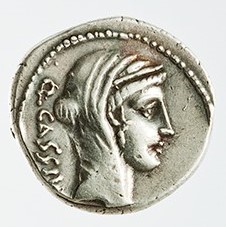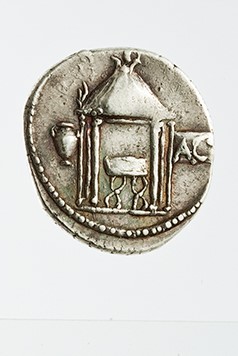Title: Denarius of Q. Cassius Longinus - 1979.02
Acquisition number: 1979.02
Author or editor: Beryl Rawson
Culture or period: Roman Republic
Date: 55 BC
Material: Metal - Silver
Object type: Coins - Roman
Dimensions: 17mm (w)
Origin region or location: Italy
Origin city: Rome
Display case or on loan: 5
Keywords: Coin, denarius, Roman, Republic, Vesta
Sear, D.R., Roman Coins and their Values 5 vols (London, Spink, 2000-2014) 389;Crawford, M., Roman Republican Coinage 2 vols (Cambridge, Cambridge University Press, 2011) 428/1; Sydenham, E. A. The Coinage of the Roman Republic (London, Spink, 1952; (Sanford J. Durst repr. 1976) 917, 917a; Seaby, H.A., Roman Silver Coins (London, B.A. Seaby, 1967) Cassia 9, 9a; Grueber, H.A., Coins of the Roman Republic in the British Museum 3 vols (London, The Trustees of the British Museum, 1910; rev. edn London, 1970) I. 3871.
1979.02
Denarius of Q. Cassius Longinus
3.07 g. 55 BC
Obv.: Head of Vesta, r., veiled and diademed; behind, Q. CASSIV[S] (downwards); before, [VESTA] (upwards).
Rev.: Temple of Vesta, curule chair within; to l., voting urn; to r., voting tablet, inscribed A. C.
The circular temple of Vesta stood in the Roman Forum. The moneyer Q. Cassius Longinus commemorates the activity of an ancestor (L. Cassius Longinus Ravilla) in the trial and conviction of several Vestal Virgins in 113 BC on charges (incestum) of breaking their vows of chastity. Two Vestals had been acquitted of this charge in 114 BC, perhaps helped by their powerful family connections. Popular discontent led to new trials in 113 BC, under a special prosecutor (Longinus Ravilla), which resulted in a number of convictions. These Vestals were put to death. There was criticism of the harshness of these convictions, but the moneyer of 55 BC clearly alludes to the episode to the credit of his ancestor. Perhaps there were fresh allegations about Vestals in the 50s BC.
Charges against Vestals could have some credibility, as these were privileged women who moved freely in society. But charges may have been motivated by a wish to curb their political influence or that of their connections. Moreover, prosecutions were sometimes provoked, in times of national crisis, by heightened tensions in society. In 114 BC there were rumblings of imminent threats to Roman power, from Africa and the eastern Mediterranean and the northern borders. In the late Republic there were many internal tensions, and the Vestals are known to have been politically active in the late 60s BC.
The voting tablets represent the choices available in trials: A. for absoluo (‘I acquit’) and C. for condemno (‘I convict’).
Sear, D.R., Roman Coins and their Values 5 vols (London, Spink, 2000-2014) 389;Crawford, M., Roman Republican Coinage 2 vols (Cambridge, Cambridge University Press, 2011) 428/1; Sydenham, E. A. The Coinage of the Roman Republic (London, Spink, 1952; (Sanford J. Durst repr. 1976) 917, 917a; Seaby, H.A., Roman Silver Coins (London, B.A. Seaby, 1967) Cassia 9, 9a; Grueber, H.A., Coins of the Roman Republic in the British Museum 3 vols (London, The Trustees of the British Museum, 1910; rev. edn London, 1970) I. 3871.

